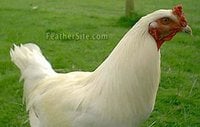General Information
- Breed Purpose
- Dual Purpose
- Comb
- Pea
- Broodiness
- Seldom
- Climate Tolerance
- All Climates
- Egg Productivity
- High
- Egg Size
- Medium
- Egg Color
- Pink
- Breed Temperament
- Docile
- Breed Colors/Varieties
- White
- Breed Size
- Large Fowl
The Ixworth is a breed of chicken originating in the village of Ixworth in Suffolk, England. It is a dual-purpose fowl that comes in single, white-feathered variety. Developed in 1932, it was created from crosses of the white types of Sussex, Minorca, Orpington and Indian Game chickens. With the white skin valued in the British market, it is especially suited to meat production. They have pea combs and lay a fair amount of eggs.
------------------------------------------------------------------------------------------------------------------------
Reginald Appleyard began the development of the Ixworth breed in the village of Ixworth in Suffolk and finally finished in 1939 when the breed made its first appearance. He is the same gentleman who developed the Silver Appleyard duck. The idea was to create a breed, which was a quickly maturing table breed, which also produced a good number of eggs. He used the White Old English Game, Jubilee Indian Game, White Sussex, White Orpington and White Minorca to create this new breed and the combination has produced a fine white skinned, broad-breasted bird for the table. It is another very rare breed, which almost disappeared between 1950 and 1970 and now has a much bigger following in the Shropshire area but is still at a critical level. The plumage is always white and the birds possess a pea comb, orange to red eyes, pinky-white legs and beak. They are only slightly behind the Light Sussex in egg production and egg weight. A bantam version appeared in 1938 but has subsequently all but disappeared.
------------------------------------------------------------------------------------------------------------------------
Reginald Appleyard began the development of the Ixworth breed in the village of Ixworth in Suffolk and finally finished in 1939 when the breed made its first appearance. He is the same gentleman who developed the Silver Appleyard duck. The idea was to create a breed, which was a quickly maturing table breed, which also produced a good number of eggs. He used the White Old English Game, Jubilee Indian Game, White Sussex, White Orpington and White Minorca to create this new breed and the combination has produced a fine white skinned, broad-breasted bird for the table. It is another very rare breed, which almost disappeared between 1950 and 1970 and now has a much bigger following in the Shropshire area but is still at a critical level. The plumage is always white and the birds possess a pea comb, orange to red eyes, pinky-white legs and beak. They are only slightly behind the Light Sussex in egg production and egg weight. A bantam version appeared in 1938 but has subsequently all but disappeared.

